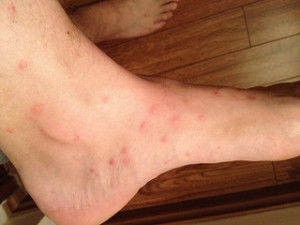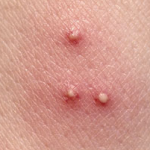Flea bites on humans are surprisingly common, especially if you have any four legged friends around the house. However even if you don’t have pets, your yard can potentially be home to fleas. Fleas typically spend more than three-quarters of their life away from a host animal and they can live for weeks or even months without food in house’s carpets and bedding, or your yard.
But how do you tell them apart from other insect bites and how do you treat them? Read on to find out more
Do Fleas Bite Humans?
While these resilient little insects may have names like human fleas, dog fleas and cat fleas they can in fact feed on the blood of many different mammals, including humans. So while some species of flea may be better adapted to one animal over another, eg cat fleas or dog fleas, they are more than happy to take a bite out of plenty of other species.
An adult flea can live for several weeks without food, the females cannot lay eggs without getting some blood, so sooner or later they are going to be looking for a meal and we make a pretty good feast for them regardless of their preferred meal.
What Do Flea Bites Look Like?
Fleas are tiny, less than 2mm in length (or the size a pen tip) and wingless. However they have developed strong rear legs that allow them to leap massive distances compared to their size, as much as 9 inches/22 cm! This allows them to jump onto any new host nearby and then move around on their victim.

They will also migrate towards places where there is a good blood supply near the surface of the skin, for example in the fold of your elbow or knee, or where clothing is usually most snug against the skin such as your waist. They also like to be around areas of hair growth such as your head, armpit or groin, so you often find bites in these areas too.

At first glance they look somewhat similar to a mosquito bite, however unlike a mosquito bite they remain small and you typically find them in a line or group. This happens because a mosquito will simply bite, feed and then fly away. Fleas on the other hand do not fly so can take on board much more blood, as much as 140% of its body weight. This feeding can take quite some time; typically females feed for 25 minutes and males for 11 minutes.
Due to the amount of time it takes, fleas often get disturbed when feeding, for example by the host’s clothing when they move, which can cause them to stop feeding and move a short distance before starting the process over again. This gives the tell-tale groups of bites.
Are Flea Bites Dangerous to Humans?
Fleas were once a major danger to humans – they were responsible for transmitting the bubonic plague bacteria through the rat population but these days the treatment of bacteria and viruses makes this far less of a risk, especially in the developed world.
Fleas can also spread the eggs of tapeworm into a human’s blood stream but once again, this is a minimal risk in the developed world as quite simply there are not many tapeworms to spread the eggs of.
These days fleas are generally more a nuisance than anything, however there are circumstances where a bite can be more hazardous; infection and allergic reaction.
Infected Flea Bites
Fleas often defecate whilst feeding (although most of this is just undigested blood) and our fingernails can also often carry a lot of dirt so scratching can potentially move this into the wound, causing bacterial infections.
To address this, it is best to wash the bites with an [easyazon_link keywords=”antiseptic soap” locale=”UK” tag=”flea-bites-co-uk-21″]antiseptic soap[/easyazon_link] as soon as you notice them to reduce the chance of infection. However if you see white-topped blisters and/or a rash around the bites you should see a doctor as your bites may have become infected.
What to do if you have an allergic Reaction to Fleabites
You may find it surprising, but the bite itself is not what causes the reaction. Flea bites actually cause a tiny and generally very clean wound, but the flea also spreads its’ saliva over the wound. Flea’s saliva has several properties; it softens the skin, stops the blood clotting and acts as a numbing agent to prevent detection as they feed. It is the flea saliva that our bodies generally react to.
In this case of an allergic reaction our immune system overreacts to the flea’s saliva and releases an excess of histamine, our body’s natural defense. Most of the time the symptoms are no worse than for something like hay-fever but, depending on the severity of the reaction, they could include:
- Severe itching
- A rash or hives on various parts of the body
- Shortness of breath, wheezing or difficulty breathing
- Swelling of the face, hands, mouth, or lips
Typically an anti-histamine like diphenhydramine (found in [easyazon_link identifier=”B001AW14MK” locale=”UK” tag=”flea-bites-co-uk-21″]Benadryl[/easyazon_link] and other allergy treatments) will alleviate these symptoms.
In the worst cases people can experience Anaphylaxis and even anaphylactic shock. This can be life threatening if it isn’t treated immediately. or use an epinephrine injection (EpiPen) if you’re having difficulty breathing.
Call 999 or go to A&E immediately if you believe you’re having a severe allergic reaction to a fleabite.
How Long Do Flea Bites Last?
Flea bites can remain itchy and inflamed for several weeks. However if you scratch them, they can become inflamed and even get infected. Scratching these irritating spots is very tempting however it is important to try not to!
Why Do Flea Bites Itch?
As mentioned before Flea’s saliva has several properties that help them feed on their host’s blood. This is great for the flea but it stays in the wound and once the anesthetic effect wears off. Our body’s reaction to this is the primary cause of the skin itching, not the actual bite itself.
How Do You Stop Flea Bites Itching?
Flea bites typically go away on their own but you should try to keep the itching under control while the bites heal as scratches can cause them to get infected.
For some natural relief, a tepid (ie not hot!) bath will help calm the bites down and if there is any swelling around the area apply a cold ice pack for some relief. This will temporarily relieve the itch and numb the area and for many people this is enough to keep a lid on the irritation.
If that does not work for you there are other treatments both natural homemade and over the counter, which you can read about in our article on how to treat flea bites.
Getting rid of fleas
While these techniques work well in treating the unpleasant symptoms of flea bites, the only long term solution is to treat the actual cause. This usually means purchasing flea spray/drops, carpet shampoo, etc for your home and treatments plus other accessories like flea collars for your pets. You can read more about the best treatments for your home, your dog and cats here